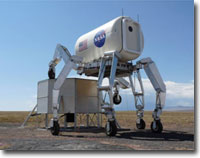NASA Advances 3D Printing on the Moon

NASA’s ATHLETE, designed for lunar exploration, may soon get a 3D printing attachment. Courtesy of NASA.
March 4, 2013
If NASA were singing a song to the European Space Agency (ESA), it might be “Anything You Can Do, I Can Do Better.” The ESA recently revealed a plan to construct a lunar base using additive manufacturing (AM), possibly following NASA’s experiment with fueling a 3D printer with crushed moon rock. Now, NASA has released information about its own plan to build a lunar base with AM, with help from a multi-legged robot.
The robot called ATHLETE (All-Terrain Hex-Legged Extra-Terrestrial Explorer), is being built by NASA’s Jet Propulsion Lab (JPL), and has been in the testing phase for a number of years now. It was designed specifically to explore the surface of the moon, and now may be refitted to add AM elements.
Unlike the ESA’s plan, which is based on Monolite UK’s D-Shape technology, ATHLETE would use microwaves to sinter lunar soil, a process that NASA has dubbed SinterHab. Eliminating the binding agent used in D-Shape would further reduce the necessity of materials transportation for what would have to be the longest supply chain ever.
“It would have a very good cost-value ratio as you don’t need to import as much material from Earth,” said JPL scientist, Tomas Rousek. “The whole expandable module, with the membranes to cover the base when built, would be carried by the same rocket that would bring other modules of the outpost, but it can build a volume four times bigger than a rigid cylindrical module. Since we don’t have the necessary transport capacity to the Moon at the moment, estimating a price now would be very inaccurate. As a comparison, the International Space Station has so far cost approximately $150 billion (£99bn) but a lunar base could be designed much more cheaply with private companies.”
We’ll have to wait and see if the ESA responds to NASA’s one-upmanship. Competition and friendly rivalry are generally good for innovation. Until then, I have to say I find the giant robot version to be the more interesting approach.
Below you’ll find a video of the ATHLETE during testing.
Source: Arstechnica, JPL
Subscribe to our FREE magazine, FREE email newsletters or both!
About the Author
John NewmanJohn Newman is a Digital Engineering contributor who focuses on 3D printing. Contact him via [email protected] and read his posts on Rapid Ready Technology.
Follow DERelated Topics







